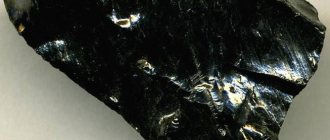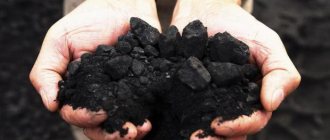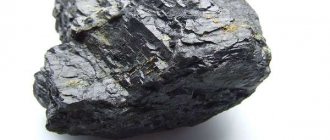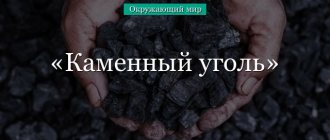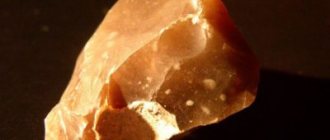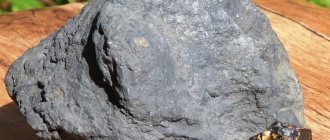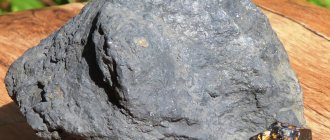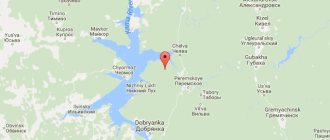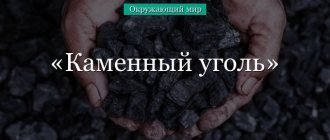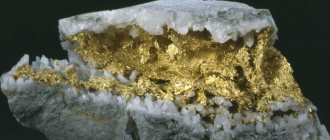Coal is a type of fossil fuel formed from parts of ancient plants underground without oxygen. The international name for carbon comes from lat. carbō (coal). Coal was the first type of fossil fuel used by humans. It enabled the industrial revolution, which in turn contributed to the development of the coal industry, providing it with more modern technology. On average, burning 1 kg of coal results in the release of 2.93 kg of CO2 and produces 23-27 MJ (6.4-7.5 kWh) of energy or, with an efficiency of 30%, 2.0 kWh of electricity. In 1960, coal provided about 50% of global energy production; by 1970, its share had fallen to 1/3. Coal use increases during periods of high oil and other energy prices. The shale revolution in the United States forced a reduction in the price of American coal, the supply of which began to displace more expensive fuel in Europe.
For the formation of coal, abundant accumulation of plant matter is necessary.
In ancient peat bogs, starting from the Devonian period (about 400 million years ago), organic matter accumulated, from which fossil coals were formed without access to oxygen.
Most commercial fossil coal deposits date from this period, although younger deposits also exist. The age of the oldest coal is estimated at approximately 300-400 million years. Coal, like oil and gas, is an organic substance that has undergone slow decomposition through biological and geological processes. The basis for the formation of coal is plant residues. Depending on the degree of conversion and the specific amount of carbon in coal, 4 types are distinguished:
- brown coal (lignites),
- coal,
- anthracite,
- graphite.
In Western countries there is a different classification:
- lignites,
- subbituminous coal,
- bituminous coal,
- anthracite,
- graphite.
Fossil coal:
Coal is a mineral , a solid combustible sedimentary rock, a type of fossil fuel formed from the remains of ancient plants (algae, tree ferns, horsetails, mosses, the first gymnosperms) due to their descent to great depths underground, at high temperatures and without access to oxygen .
It is an organic substance formed under the influence of biochemical, physicochemical and physical processes from the remains of ancient plants.
The name of such a chemical element as carbon comes from Lat. “carbo”, which means “coal”.
Coal as a fuel is a non-renewable natural resource. It has accumulated on Earth for millions of years.
Coal was the first fossil fuel used by mankind. Today, as a fuel and energy resource, it ranks second in importance after oil. Coal reserves on planet Earth will last for at least 270 years.
By degree of enrichment
Before use, coal undergoes an enrichment process. It is associated with an increase in the amount of carbon in the mineral composition due to the removal of mineral impurities. The most common method of cleaning coal involves immersing the mineral in an aqueous environment, where separation into mineral impurities and stone occurs, due to the low density of coal.
According to the degree of enrichment, industrial products, concentrates and sludge (fine coal dust) are distinguished. The sludge is pressed into briquettes and sold in stores for the needs of the population. The remaining types are used in large-scale industry.
Coal formation:
In the distant geological past, the Earth was covered with dense forests and vegetation, which, under the influence of natural and geological processes, were buried in the depths of the subsoil, without having time to decompose or oxidize. As the surface layer of sediments increased, the remains of ancient plants sank lower and lower. At the same time, the pressure increased and the temperature increased. Access to oxygen was closed. Due to high pressure and elevated temperature, dead vegetation was gradually converted into peat, the starting material for the formation of coal. This process is also called peat formation.
Then the peat, under the same external conditions (under the influence of elevated temperature and pressure), was transformed into brown coal (a process called coal diagenesis). After which, brown coal, as a result of changes in the chemical composition, structure and physical properties under the influence of elevated temperature and pressure (i.e. under the same external conditions), was successively transformed into hard coal and anthracite.
Under the pressure of sediment layers one kilometer thick, a 20-meter layer of peat produced a layer of brown coal 4 meters thick. If the depth of burial of plant material reaches three kilometers, then the same layer of peat turned into a layer of coal 2 meters thick. At a greater depth, about six kilometers, and at a higher temperature, the 20-meter layer of peat became a layer of anthracite 1.5 meters thick.
As a result of the movement of the earth's crust, coal seams experienced folding and uplifting right up to the very surface of the Earth. Thanks to this, it became possible to extract them from the bowels of the Earth, including by open methods.
Place of Birth
Coal is a common mineral that is mined everywhere. The United States ranks first in coal production, Russia is second, and China is third.
In Russia, mining is carried out in the mines of the Kemerovo region. The Kuzbass deposit contains up to 700 billion tons. The history of the deposit goes back to the distant 18th century, and in the second half of the 20th century coal began to be mined in Kuzbass.
Also, coal mining is carried out in Yakutia, Kazakhstan, the Republic of Khakassia, and Africa. Judging by global coal imports, Australia ranks first.
Classification of coals. Types, classes, categories, types, subtypes, etc. of fossil coals:
The classification of fossil coals is based on the following set of parameters:
– average value of an arbitrary vitrinite reflection indicator, in %,
– higher calorific value for a wet, ash-free state, in MJ/kg,
– yield of volatile substances to dry ash-free state, in%,
– sum of fusainized components per pure coal, in%,
– maximum moisture capacity in the ash-free state, in%,
– yield of semi-coking resin to dry ash-free state, in%,
– thickness of the plastic layer, in mm,
– indicator of free swelling, in units,
– volumetric yield of volatile substances in a dry, ash-free state, in cm/g,
– indicator of vitrinite reflection anisotropy, in%.
These parameters are determined by GOST 25543-2013 “Brown, hard and anthracite coals. Classification by genetic and technological parameters.”
Depending on the value of the average reflectance of vitrinite, the higher calorific value of the wet ash-free state and the release of volatile substances in the dry ash-free state (i.e., depending on the first three parameters), three types of fossil coal are distinguished: brown coal, hard coal and anthracite . See table below.
Table 1. Division of fossil coals into types.
| Type of coal | Average vitrinite reflectance, % | Higher calorific value for wet ash-free state, MJ/kg | Yield of volatile substances to dry ash-free state, % |
| Brown coal | Less than 0.60 | Less than 24 | – |
| Coal | From 0.40 to 2.59 inclusive | 24 or more | 8 or more |
| Anthracite | From 2.20 and more | – | Less than 8 |
Brown coal is a coal of low metamorphic stage with a vitrinite reflectance of less than 0.60%, provided that the gross calorific value (in the wet, ash-free state of the coal) is less than 24 MJ/kg.
Hard coal is a coal of the middle stage of metamorphism with a vitrinite reflectance from 0.40% to 2.59%, provided that the gross calorific value (in the wet ashless state of the coal) is equal to or higher than 24 MJ/kg, and the yield of volatile substances (at dry ash-free state of coal) is 8% or more.
Anthracite is a coal of a high stage of metamorphism with a vitrinite reflection index of 2.20% or higher, provided that the yield of volatile substances (on a dry, ash-free state of coal) is at least 8%.
But this classification of coals is incomplete. There are several other types of coals that are not found in everyday life, but are used in specialized and scientific literature. They represent variations of the above species. For example, lignite, subbituminous coal, and oxidized coal (weathered coal). They are given in GOST 17070-87 “Coals. Terms and Definitions".
Lignite is a type of brown coal, represented by fossil, lightly carbonized brown wood that has preserved the anatomical structure of plant tissues. In appearance, lignite is similar to unchanged wood.
Oxidized coal (weathered coal) is coal that has changed its properties as a result of exposure to oxygen and moisture when deposited in seams or during storage.
Based on their origin, fossil coals are divided into the following types: humolites, liptobiolites and sapropelites.
Humolite is coal formed primarily from the transformation products of dead higher plants.
Liptobiolite is a humolite formed primarily from biochemically stable plant components, which include cuticles, spores, pollen, resinous substances and cork tissues.
Sapropelite is coal formed primarily from the products of the transformation of dead lower plants and simple animal organisms under anaerobic conditions.
Brown coals, bituminous coals and anthracites, depending on genetic characteristics, are divided into:
– classes – according to the average vitrinite reflectance,
– categories – according to the content of fusainized components versus pure coal.
Fossil coals, depending on technological features, are divided into types and subtypes according to other parameters.
The class, category, types and subtype of fossil coal is reflected in its 7-digit encoding. This is adopted for convenience in order to clearly define the physical and chemical characteristics and properties of coal.
Finding
This graph shows the percentage of ore blocks versus absolute height.
Sometimes you can be so lucky.
All blocks except ores and bedrock have been removed from the chunk.
Another kind.
In Minecraft Beta, there is the following distribution of ores by height (the height count starts from the bottom level of the bedrock). After Beta 1.8, the upper limit for finding gold, redstone and diamonds is 2 blocks lower.
| Ore type | Usual location to... | Most often found on… | Rarely between... | Never higher... | Required Pickaxe |
| Ordinary world | |||||
| Coal Ore | Height 128 | Height 29 | Height 129-131 | Height 132 | |
| Iron ore | Height 64 | Height 35 | Height 65-67 | Height 68 | |
| Gold Ore | Height 29 | Height 20 | Height 31-33 | Height 34 | |
| Emerald Ore | Height 29 | Height 20 | Height 29-31 | Height 33 | |
| Lapis lazuli ore | Height 23 | Height 14 | Height 31-33 | Height 33 | |
| Red Ore | Height 15 | Height 8 | Height 16 | Height 17 | |
| Diamond ore | Height 12 | Height 10 | Height 13-15 | Height 16 | |
| lower world | |||||
| Quartz Ore | 128 | Unknown | Unknown | Unknown |
- Based on experimental data
- Only in the mountain biome.
Red ore is located on the same level as diamond, but it is generated 8 times per chunk versus 1 time per chunk for diamond.
Coal grades:
Brown coals, bituminous coals and anthracites, depending on their technological properties and genetic characteristics (i.e. depending on the class, category, type and subtype of fossil coal, which is reflected in its labeling) are combined into grades, technological groups and subgroups according to GOST 25543-2013, which determine the direction of further use of fossil coals.
This GOST establishes the following grades of fossil coals: brown, long-flame, long-flame gas, gas, gas fat lean, gas, fat, coke fat, coke, coke lean, coke low-caking low-metamorphosed, coke low-caking, lean caking, lean caking, low-caking, lean, anthracite. There are 16 brands of coal in total.
Thus, depending on the coding of a particular fossil coal, its grade, technological group and subgroup, as well as the direction of further use (technological, energy, in the production of building materials, etc.) can be clearly established.
For example, coal from the Lenin mine of seam XVII of the Kuznetsk basin is characterized by the following indicators:
– vitrinite reflectance 1.48%;
– content of fusainized components 43%;
– yield of volatile substances 18.3%;
– plastic layer thickness 10 mm.
This coal, in accordance with GOST 25543-2013, belongs to class 14, category 4, type 18, subtype 10. Code number 1441810. Further, this coal belongs to the OS grade (lean sintering), group 1OS (first lean sintering), subgroup 1OSF (first lean sintering fusinite). Accordingly, it can be used in a technological direction - in layer coking.
Gold mining industry
Story
In 1843, by decree of the government, gold mining was allowed for private entrepreneurs in western Transbaikalia, in the Verkhneudinsky district, which at that time included the Vitim taiga, with a levy in kind in favor of the Cabinet for gold mining of up to two poods per year - 5%, from two to five poods - 10%, over five poods - 15%. Gold mining in Buryatia began in the Barguzin taiga in 1844 with work at the Innokentyevsky mine, on the Bugarichta River (Tsipa basin) and Mariinsky, on the Baychikan stream, which flows into the Toloi River in the Tsipican River system. At these two mines in 1844, 1031 pounds of sand were washed and 7 spools of 9 shares (30 grams 260 milligrams) of gold were mined. The first information about gold placers discovered along the Bambuika River dates back to 1856 and is associated with the name of mining engineer V. M. Buivit. He discovered placers in the valleys of the Teleshma and Zhitonda springs.
By 1861, in the Western Transbaikal mountain district there were 11 gold mining companies with a total of 25 mines. Of these, 15 mines were located in the Barguzinsky district.
In the Soviet years, gold mining was carried out almost exclusively from placers and did not exceed 1.5-2 tons per year.
Main characteristics
Gold mining is one of the main sources of income for the budget of Buryatia. Geologists have identified more than 240 deposits of this precious metal on its territory [ source not specified 1965 days
].
Buryatia, occupying a little more than 2% of the area of Russia, contains in its depths a large gold potential [ source not specified 1965 days
].
In terms of balance reserves of gold, the Republic of Buryatia ranks 14th among the constituent entities of the Russian Federation [ source not specified 1965 days
].
In general, as of 01/01/2010, gold reserves in the republic amount to 100.7 tons, the tested forecast resources of ore gold are estimated at another 1311 tons [ source not specified 1965 days
]. In terms of gold production, Buryatia ranks 9th in Russia and third in the Siberian Federal District.
Current state of the gold mining industry
Rich gold-quartz ore
Gold bars
With the commissioning of the Kholbinsky mine and the formation of the Buryatzoloto OJSC organization, the level of ore gold production began to increase by 150-600 kg annually. In 2000, the increase reached a maximum of 1000 kg. Between 2000 and 2008, the ratio of ore and placer gold production changed from 61% and 39% to 80% and 20%, respectively. Currently, in Buryatia, most of the gold is mined from primary deposits. Gold mining is carried out in six regions of the republic, mainly in the Okinsky, Bauntovsky and Muisky districts.
- The main gold mines and mines of Buryatia (as of 2009): Irokinda (production - 2329 kg)
- Kholbinsky (Samartinsky) (2,263kg)
- Kedrovskoye (946 kg)
- Mine Tsipikansky (233 kg)
- Konevinskoye field (221kg)
- The main gold mining organizations operating in Buryatia (as of 2012): OJSC Buryatzoloto (Irokinda and Kholbinsky mines) (production - 4,170 kg)
- LLC "Artel of Prospectors Western" (Kedrovsky mine) (946kg)
- CJSC "Vitimgeoprom" (302kg)
- LLC "Artel Prospectors Sininda-1" (232kg)
- LLC "Artel Prospectors Kurba" (208kg)
- Khuzhir Enterprise LLC (Konevinskoye field) (221kg)
- LLC "Priisk Tsipikansky" (233kg)
Dredge
In general, in the gold mining industry of Buryatia there has been a steady downward trend in gold production. If the decrease in production from ore deposits is relatively weak (about 2% per year), then the annual decrease in alluvial gold production averages 440 kg (15 - 36%). Among the problems hindering the development of gold mining, the following should be highlighted: 1) low supply of gold mining enterprises with proven reserves. Most of the previously explored deposits (mainly during the Soviet period) have been developed. 2) it is unprofitable for enterprises to invest in the search and exploration of placers; exploration requires significant costs with mixed results. 3) administrative and bureaucratic factor.
Brown coal:
Brown coal is a hard fossil coal formed from peat, the youngest of fossil coals. It is formed from dead organic remains under elevated pressure and under the influence of elevated temperature at depths of about one kilometer.
It has a black-brown or black color, less often brown (the line on porcelain tiles is always brown).
Contains 50-77% carbon, 20-30% (sometimes up to 40%) moisture (water) and a large amount of volatile substances (up to 50%). Due to its chemical composition, brown coal burns easier and produces more smoke and odor.
Since it contains a lot of water, it has a low calorific value - less than 24 MJ/kg. In air, brown coal quickly loses moisture, cracks and turns into powder.
Amazing Finds
The most interesting finds in the coal layers are tree trunks lying vertically. They often cross huge strata of rock perpendicular to the coal bedding. Trees in this vertical position are often found in layers associated with coal deposits, and a little less often in the coal itself. Many are of the opinion about moving tree trunks.
The amazing thing is that sediment had to accumulate so quickly to cover these trees before they deteriorated (rotted) and fell.
Here is a rather interesting history of the formation of a rock called coal. The formation of such layers in the bowels of the earth is a reason for further research in search of answers to numerous questions.
Coal:
Hard coal is a hard fossil coal, intermediate between brown coal and anthracite. It is formed under elevated pressure and under the influence of elevated temperature from brown coal at depths of about three kilometers.
Has black color.
Contains 75-95% carbon, up to 12% (3-4% internal) moisture (water) and up to 32% volatile substances. It ignites well.
Since the moisture content is low, it therefore has a higher calorific value compared to brown coals - more than 24 MJ/kg.
Notes
- F. A. Kudryavtsev.
The origin of gold mining in Western Transbaikalia // Buryatievedenie. Verkhneudinsk 1927. pp.32-39 - G. A. Verkhoturova, V. F. Zherlov.
Golden land of Buryatia. - ↑ (inaccessible link). Retrieved April 13, 2014.
- ↑
- ↑ Coal of Buryatia: we use one tenth
- ↑
- ↑. catalogmineralov.ru.
- ↑. webmineral.ru.
- . information agency "Baikal Media Consulting" (05/02/2012).
- . News Agency “Baikal-Daily” (05/27/2011).
- . Rabochaya Gazeta - All-Russian newspaper of workers (02/26/2008). (unavailable link)
- St. Petersburg State Mining Institute named after.
Plekhanov in the Republic of Buryatia. Ermakovskoye field... - National Library of the Republic of Buryatia.
. - (unavailable link). Retrieved July 31, 2014. [ not in source
] - ↑ Yu // Encyclopedic Dictionary of Brockhaus and Efron: In 86 volumes (82 volumes and 4 additional). - St. Petersburg, 1890-1907.
- Colored stones of the Transbaikal region
- "Evening Chelyabinsk".
. - ↑ National Library of the Republic of Buryatia.
.
Anthracite:
Anthracite is a hard fossil coal, coal with the highest degree of carbonization (metamorphism). It is formed under elevated pressure and under the influence of elevated temperature from coal at depths of about six kilometers. They are a transitional form from coal to graphite.
It has a rich black or black-gray color and a metallic sheen.
Contains 95% carbon, 1-3% moisture (water) and up to 8% volatile substances. Burns quickly, without smoke or flame.
Anthracite reserves account for only three percent of the world's total coal reserves.
Additionally
- As of version 1.0, Diamonds, Lapis Lazuli, Redstone, and Coal can be mined as an ore block using the Silk Touch enchantment.
- Ore veins cannot be located at the junction of chunks.
- Lapis lazuli, emerald and quartz are the only ores that differ from the others in texture. All other ores have the same texture with different colors.
- Natural structures passing through deposits destroy ores as well as stone.
| Blocks | |
| Natural | Air Andesite Cobble Clay Block Head Gravel Granite Diorite Mossy Cobblestone Earth Stone Bedrock Ice Dense Prismarine Brick Dark Wet Sponge Sea Lantern Obsidian Web Sand Red Sandstone Red Podzol Snow Mob Spawner |
| Man-made | Slime Block Cobblestone Wall Mossy Smooth Andesite Smooth Granite Smooth Diorite Bed Planks Iron Lattice Fence Stone Brick Bricks Bookcase Staircase Baked Clay Stove Jack-O-Lantern Snow Block Hay Sheaf Glass Panel Glass Panel Painted Glass Steps Charcoal Block Flag Flower Pot Wool Carpet Iron Block Gold Block Diamond Block Lapis Lazuli Block Emerald Block Red_stone_(block) Quartz Block Slab Steps |
| Adaptations | Workbench Sponge Stove Enchanting Table Cooking Stand Chest Edge Cauldron Bed Lighthouse Anvil TNT Player Cake |
| Mechanisms | GateEjectorDaylight SensorDoor Feed HopperButtonCommand Unit Red Stone Wire Torch Repeater Comparator Lamp Hatch Music Unit Pressure Plate Weighted Tension Sensor Piston Sticky Dispenser Stretch Rails Push Electric Activating Lever Chest Trap |
| Plants | Watermelon Tall grass Mushrooms Huge Wood Cactus Water lily Lianas Foliage Mycelium Cocoa fruit Sapling Sugar cane Dry bush Grass Pumpkin Flowers |
| Ore | Diamond Ore Iron Ore Gold Ore Emerald Ore Nether Quartz Ore Red Ore Lapis Lazuli Ore Coal Ore |
| Liquids | Water Lava |
| Fragile | Sign Torch Fire |
| lower world | Hell Stone Hell Brick Hell Fence Hell Wart Soul Sand Glowstone |
| edge | End Stone Dragon Egg |
| Only in Creative | Sponge |
| Only in pocket version | Blue Flower Nether Reactor Core Glowing Obsidian |
| Technical | Block 36 |
| Planned | Barrier |
| Deleted | Gear Earth Slab Locked Chest |
| Unrealized | Weeping Obsidian Block Upgrade Sensor Lantern Chair Pulpit Spikes |
Extraction methods
The choice of extraction method depends on geological and natural conditions, the availability of infrastructure, economic and social prerequisites. The main attention is paid to the following factors:
- quantity, quality, thickness and angle of inclination of layers, depth of their occurrence;
- the nature and thickness of interstratal sedimentary rocks;
- features of surface relief;
- accessibility of transport, energy networks and processing enterprises;
- environmental consequences;
- form of ownership of the land plot and its current use.
All this data serves to determine the profitability of the future enterprise, and also helps to make a choice between surface and underground mining. An analysis of world production shows that in terms of quantitative indicators, both methods are approximately equal, but depend on the type of coal:
- anthracite accounts for about 10% of world production and is mined underground;
- lignite seams (25%) are most often extracted from quarries;
- bituminous coals (65%) are mined by both methods in approximately equal proportions.
The open method is considered cheaper and less dangerous, but very harmful to the environment. It is used in cases where the fossil lies at a depth of no more than 100 m. Coal is extracted from quarries using special equipment: graders, bulldozers, excavators and heavy-duty dump trucks. The height of some machines can be compared to a multi-story building.
The most valuable grades of coal are developed using a closed method, and this justifies the economic costs associated with the construction and operation of mines. For example, the most valuable anthracite is lifted from a depth of more than 1.5 km. This technology consists of drilling a vertical shaft, from which horizontal and inclined workings are diverted, leading to productive formations. Mining work has always been very dangerous due to collapses, methane emissions and difficult conditions, but nowadays it is increasingly automated and coal mining combines and other equipment take the place of people.
Where do the lumps in coal come from?
An impressive external feature of coal is that it contains huge lumps. These large blocks have been found in coal seams of many deposits for more than a hundred years. The average weight of 40 lumps collected from the West Virginia coalfield was about 12 pounds, and the largest was 161 pounds. Moreover, many of them were metamorphic or volcanic rock.
Researcher Price suggested that they could have been transported to the coal deposits in Virginia from afar, entwined in the roots of trees. This conclusion also supports the allochthonous model of coal formation.
